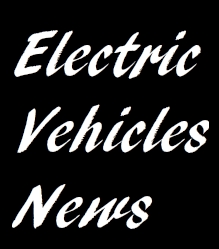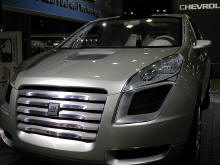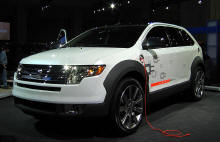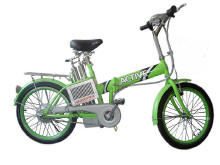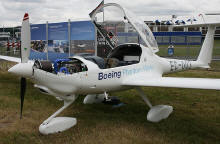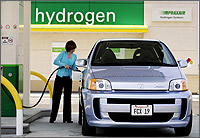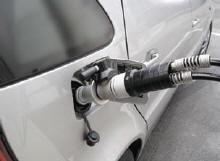Hydrogen Vehicle
|
A hydrogen vehicle is an alternative fuel vehicle that uses hydrogen as its onboard fuel for motive power. The term may refer to a personal transportation vehicle, such as an automobile, or any other vehicle that uses hydrogen in a similar fashion, such as an aircraft. The power plants of such vehicles convert the chemical energy of hydrogen to mechanical energy either by burning hydrogen in an internal combustion engine, or by reacting hydrogen with oxygen in a fuel cell to run electric motors. Widespread use of hydrogen for fueling transportation is a key element of a proposed hydrogen economy. Hydrogen fuel does not occur naturally on Earth and thus is not an energy source, but is an energy carrier. Currently it is most frequently made from methane or other fossil fuels. However, it can be produced from a wide range of sources (such as wind, solar, or nuclear) that are intermittent, too diffuse or too cumbersome to directly propel vehicles. Integrated wind-to-hydrogen plants, using electrolysis of water, are exploring technologies to deliver costs low enough, and quantities great enough, to compete with traditional energy sources. Many companies are working to develop technologies that might efficiently exploit the potential of hydrogen energy for mobile uses. The attraction of using hydrogen as an energy currency is that, if hydrogen is prepared without using fossil fuel inputs, vehicle propulsion would not contribute to carbon dioxide emissions. The drawbacks of hydrogen use are low energy content per unit volume, high tankage weights, the storage, transportation and filling of gaseous or liquid hydrogen in vehicles, the large investment in infrastructure that would be required to fuel vehicles, and the inefficiency of production processes. VehiclesBuses, trains, PHB bicycles, canal boats, cargo bikes, golf carts, motorcycles, wheelchairs, ships, airplanes, submarines, and rockets can already run on hydrogen, in various forms. NASA uses hydrogen to launch Space Shuttles into space. There is even a working toy model car that runs on solar power, using a regenerative fuel cell to store energy in the form of hydrogen and oxygen gas. It can then convert the fuel back into water to release the solar energy. The current land speed record for a hydrogen-powered vehicle is 286.476 mph (461.038 km/h) set by Ohio State University's Buckeye Bullet 2, which achieved a "flying-mile" speed of 280.007 mph (450.628 km/h) at the Bonneville Salt Flats in August 2008. For production-style vehicles, the current record for a hydrogen-powered vehicle is 333.38 km/h (207.2 mph) set by a prototype Ford Fusion Hydrogen 999 Fuel Cell Race Car at Bonneville Salt Flats in Wendover, Utah in August 2007. It was accompanied by a large compressed oxygen tank to increase power. Honda has also created a concept called the FC Sport, which may be able to beat that record if put into production. AutomobilesMany companies are currently researching the feasibility of building hydrogen cars, and most of the automobile manufacturers had begun developing hydrogen cars. Funding has come from both private and government sources. However, the Ford Motor Company has dropped its plans to develop hydrogen cars, stating that "The next major step in Ford’s plan is to increase over time the volume of electrified vehicles". Similarly, French Renault-Nissan announced in 2009 that it is cancelling its hydrogen car R&D efforts. As of October 2009, General Motors CEO Fritz Henderson noted that GM had reduced its hydrogen program because the cost of building hydrogen cars was too high. "It's still a ways away from commercialization", he said. The "Volt will likely cost around $40,000 while a hydrogen vehicle would cost around $400,000. Most hydrogen cars are currently only available in demonstration models or in a lease construction in limited numbers and are not yet ready for general public use. The estimated number of hydrogen-powered cars in the United States was 200 as of October 2009, mostly in California.
Honda introduced its fuel cell vehicle in 1999 called the FCX and have since then introduced the second generation FCX Clarity. In 2007 at the Greater Los Angeles Auto Show, Honda unveiled the first production model of the FCX Clarity. Limited marketing of the FCX Clarity began in June 2008 in the United States, and it was introduced in Japan in November 2008. The FCX Clarity is available in the U.S. only in Los Angeles Area, where 16 hydrogen filling stations are available, and as of July 2009, 10 drivers had leased the Clarity for US$600 a month. Honda stated that it could start mass producing vehicles based on the FCX concept by the year 2020. Honda reaffirmed, in 2009, that it continues to put resources into hydrogen fuel cell development, which it sees as "a better long term bet than batteries and plug-in vehicles". In 2008, Hyundai announced its intention to produce 500 FC vehicles by 2010 and to start mass production of its FC vehicles in 2012. In early 2009, Daimler announced plans to begin its FC vehicle production in 2009 with the aim of 100,000 vehicles in 2012-2013. In 2009, Nissan started testing a new FC vehicle in Japan. In February 2010 Lotus Cars announced that it was developing a fleet of hydrogen taxis in London, with the hope of them being ready to trial by the 2012 Olympic Games. London's deputy mayor, Kit Malthouse, said he hoped six filling stations would be available and that around 20-50 taxis would be in operation by then, as well as 150 hydrogen-powered buses. BusesFuel cell buses (as opposed to hydrogen fueled buses) are being trialed by several manufacturers in different locations. The Fuel Cell Bus Club is a global fuel cell bus testing collaboration. Hydrogen was first stored in roof mounted tanks, although models are now incorporating inboard tanks. Some double deck models uses between floor tanks. BicyclesPearl Hydrogen Power Sources of Shanghai, China, unveiled a hydrogen bicycle at the 9th China International Exhibition on Gas Technology, Equipment and Applications in 2007. Motorcycles and scooters ENV is developing electric motorcycles powered by a hydrogen fuel cell, including the Crosscage and Biplane. Other manufacturers as Vectrix are working on hydrogen scooters. Finally, hydrogen fuel cell-electric hybrid scooters are being made such as the Suzuki Burgman Fuel cell scooter and the FHybrid. QuadsAutostudi S.r.l's H-Due is a hydrogen-powered quad, capable of transporting 2 passengers. TractorsA concept for a hydrogen powered tractor has been proposed. AirplanesCompanies such as Boeing, Lange Aviation, and the German Aerospace Center are pursuing hydrogen as fuel for manned and unmanned airplanes. In February 2008 Boeing tested a manned flight of a small aircraft powered by a hydrogen fuel cell. Unmanned hydrogen planes have also been tested. For large passenger airplanes however, The Times reported that "Boeing said that hydrogen fuel cells were unlikely to power the engines of large passenger jet airplanes but could be used as backup or auxiliary power units onboard."
In Europe, the Reaction Engines A2 has been proposed to use the thermodynamic properties of liquid hydrogen to achieve very high speed, long distance (antipodal) flight by burning it in a precooled jet engine. Fork trucksA HICE forklift or HICE lift truck is a hydrogen fueled, internal combustion engine powered industrial forklift truck used to lift and transport materials. The first production HICE forklift truck based on the Linde X39 Diesel was presented at an exposition in Hannover on May 27, 2008. It used a 2.0 liter, 43 kW diesel internal combustion engine converted to use hydrogen as a fuel with the use of a compressor and direct injection. The hydrogen tank is filled with 26 liters of hydrogen at 350 bar pressure. RocketsRockets employ hydrogen because hydrogen gives the highest effective exhaust velocity as well as giving a lower net weight of propellant than other fuels. It performs particularly well on upper stages, although it has been used on lower stages as well, usually in conjunction with a dense fuel booster. The main disadvantage of hydrogen in this application is the low density and deeply cryogenic nature, requiring insulation- this makes the hydrogen tanks relatively heavy, which greatly offsets much of the otherwise overwhelming advantages for this application. The main advantage of hydrogen is that although the velocity change of a stage employing it is little different to a stage using denser fuel, the lift-off weight of the stage is less. Particularly when used for upper stages this permits a lighter rocket for any given payload. Internal combustion vehicleHydrogen internal combustion engine cars are different from hydrogen fuel cell cars. The hydrogen internal combustion car is a slightly modified version of the traditional gasoline internal combustion engine car. These hydrogen engines burn fuel in the same manner that gasoline engines do. Francois Isaac de Rivaz designed in 1807 the first hydrogen-fueled internal combustion engine. Paul Dieges patented in 1970 a modification to internal combustion engines which allowed a gasoline-powered engine to run on hydrogen US patent 3844262. Mazda has developed Wankel engines that burn hydrogen. The advantage of using ICE (internal combustion engine) such as wankel and piston engines is that the cost of retooling for production is much lower. Existing-technology ICE can still be used to solve those problems where fuel cells are not a viable solution as yet, for example in cold-weather applications. HICE forklift trucks have been demonstrated based on converted diesel internal combustion engines with direct injection. Fuel cellWhile fuel cells themselves are potentially highly energy efficient, and working prototypes were made by Francis Thomas Bacon in 1959 and Roger E. Billings in the 1960s, at least four technical obstacles and other political considerations exist regarding the development and use of a fuel cell-powered hydrogen car. Fuel cell costCurrently, hydrogen fuel cells are costly to produce and are fragile. As of October 2009, Fortune magazine estimated the cost of producing the Honda Clarity at $300,000 per car. Engineers are studying how to produce inexpensive fuel cells that are robust enough to survive the bumps and vibrations that all automobiles experience. Also, many designs require rare substances such as platinum as a catalyst in order to work properly. Such a catalyst can also become contaminated by impurities in the hydrogen supply. In the past few years, however, a nickel-tin nanometal catalyst has been under development which may lower the cost of cells. Fuel cells are generally priced in USD/kW, and data is scarce regarding costs. Ballard Power Systems is virtually alone in publishing such data. Their 2005 figure was $73 USD/kW (based on high volume manufacturing estimates), which they said was on track to achieve the U.S. DoE's 2010 goal of $30 USD/kW. This would achieve closer parity with internal combustion engines for automotive applications, allowing a 100 kW fuel cell to be produced for $3000. 100 kW is about 134 hp. Freezing conditionsTemperatures below freezing (32 °F or 0 °C) are a concern with fuel cells operations. Operational fuel cells have an internal vaporous water environment that could solidify if the fuel cell and contents are not kept above 0° Celsius (32°F). Most fuel cell designs are not as yet robust enough to survive in below-freezing environments. Frozen solid, especially before start up, they would not be able to begin working. Once running though, heat is a byproduct of the fuel cell process, which would keep the fuel cell at an adequate operational temperature to function correctly. This makes startup of the fuel cell a concern in cold weather operation. Places such as Alaska where temperatures can reach −40 °C (−40 °F) at startup would not be able to use early model fuel cells. Ballard announced in 2006 that it had already hit the U.S. DoE's 2010 target for cold weather starting which was 50% power achieved in 30 seconds at -20 °C. Just as early gasoline cars struggled with efficiency and reliability problems before becoming universally practical, so fuel cells have to work out startup and long term reliability problems. Early gasoline engines had the characteristic of higher heat dissipation once running, whereas fuels cells emit less heat, making the warm up process somewhat less quick. Service lifeAlthough service life is coupled to cost, fuel cells have to be compared to existing machines with a service life in excess of 5000 hours for stationary and light-duty. Marine PEM fuel cells reached the target in 2004. Current service life is 7,300 hours under cycling conditions. Research is going on especially for heavy duty like in the bus trials which are targeted up to a service life of 30,000 hours. For more details on this topic, see Fuel cell. HydrogenHydrogen does not come as a pre-existing source of energy like fossil fuels, but is first produced and then stored as a carrier, much like a battery. Hydrogen for vehicle uses needs to be produced using either renewable or non-renewable energy sources. A suggested benefit of large-scale deployment of hydrogen vehicles is that it could lead to decreased emissions of greenhouse gases and ozone precursors. According to the United States Department of Energy "Producing hydrogen from natural gas does result in some greenhouse gas emissions. When compared to ICE vehicles using gasoline, however, fuel cell vehicles using hydrogen produced from natural gas reduce greenhouse gas emissions by 60%. While methods of hydrogen production that do not use fossil fuel would be more sustainable, currently renewable energy represents only a small percentage of energy generated, and power produced from renewable sources can be used in electric vehicles and for non-vehicle applications. The challenges facing the use of hydrogen in vehicles include production, storage, transport and distribution. The well-to-wheel efficiency for hydrogen, because of all these challenges will not exceed 25%. ProductionThe molecular hydrogen needed as an on-board fuel for hydrogen vehicles can be obtained through many thermochemical methods utilizing natural gas, coal (by a process known as coal gasification), liquefied petroleum gas, biomass (biomass gasification), by a process called thermolysis, or as a microbial waste product called biohydrogen or Biological hydrogen production. Most of today's hydrogen is produced using fossil energy resources, and 85% of hydrogen produced is used to remove sulfur from gasoline. Hydrogen can also be produced from water by electrolysis or by chemical reduction using chemical hydrides or aluminum. Current technologies for manufacturing hydrogen use energy in various forms, totaling between 25 and 50 percent of the higher heating value of the hydrogen fuel, used to produce, compress or liquefy, and transmit the hydrogen by pipeline or truck. Environmental consequences of the production of hydrogen from fossil energy resources include the emission of greenhouse gases, a consequence that would also result from the on-board reforming of methanol into hydrogen. Studies comparing the environmental consequences of hydrogen production and use in fuel-cell vehicles to the refining of petroleum and combustion in conventional automobile engines find a net reduction of ozone and greenhouse gases in favor of hydrogen. Hydrogen production using renewable energy resources would not create such emissions or, in the case of biomass, would create near-zero net emissions assuming new biomass is grown in place of that converted to hydrogen. However the same land could be used to create Biodiesel, usable with (at most) minor alterations to existing well developed and relatively efficient diesel engines. In either case, the scale of renewable energy production today is small and would need to be greatly expanded to be used in producing hydrogen for a significant part of transportation needs. As of December 2008, less than 3 percent of U.S. electricity was produced from renewable sources, not including dams. In a few countries, renewable sources are being used more widely to produce energy and hydrogen. For example, Iceland is using geothermal power to produce hydrogen, and Denmark is using wind. StorageHydrogen has a very low volumetric energy density at ambient conditions, equal to about one-third that of methane. Even when the fuel is stored as liquid hydrogen in a cryogenic tank or in a compressed hydrogen storage tank, the volumetric energy density (megajoules per liter) is small relative to that of gasoline. Hydrogen has a three times higher energy density by mass compared to gasoline (143 MJ/kg versus 46.9 MJ/kg). Some research has been done into using special crystalline materials to store hydrogen at greater densities and at lower pressures. A recent study by Dutch researcher Robin Gremaud has shown that metal hydride hydrogen tanks are actually 40 to 60-percent lighter than an equivalent energy battery pack on an electric vehicle permitting greater range for H2 cars. InfrastructureThe hydrogen infrastructure consists mainly of industrial hydrogen pipeline transport and hydrogen-equipped filling stations like those found on a hydrogen highway. Hydrogen stations which are not situated near a hydrogen pipeline get supply via hydrogen tanks, compressed hydrogen tube trailers, liquid hydrogen tank trucks or dedicated onsite production. Hydrogen use would require the alteration of industry and transport on a scale never seen before in history. For example, according to GM, 70% of the U.S. population lives near a hydrogen-generating facility but has just about no access to hydrogen, despite its wide availability for commercial use. The distribution of hydrogen fuel for vehicles in the U.S. would require new hydrogen stations costing, by some estimates, 20 billion dollars. and 4.6 billion in the EU. Other estimates place the cost as high as half trillion U.S. dollars in the United States alone. The California Hydrogen Highway is an initiative by the California Governor to implement a series of hydrogen refueling stations along that state. These stations are used to refuel hydrogen vehicles such as fuel cell vehicles and hydrogen combustion vehicles. As of July 2007 California had 179 fuel cell vehicles and twenty five stations were in operation, and ten more stations have been planned for assembly in California. However, there have already been three hydrogen fueling stations decommissioned. South Carolina also has a hydrogen freeway in the works. There are currently two hydrogen fueling stations, both in Aiken and Columbia, SC. Additional stations are expected in places around South Carolina such as Charleston, Myrtle Beach, Greenville, and Florence. According to the South Carolina Hydrogen & Fuel Cell Alliance, the Columbia station has a current capacity of 120 kg a day, with future plans to develop on-site hydrogen production from electrolysis and reformation. The Aiken station has a current capacity of 80 kg. There is extensive funding for Hydrogen fuel cell research and infrastructure in South Carolina. The University of South Carolina, a founding member of the South Carolina Hydrogen & Fuel Cell Alliance, received 12.5 million dollars from the Department of Energy for its Future Fuels Program. Codes and standardsHydrogen codes and standards are codes and standards (RCS) for hydrogen fuel cell vehicles. Additional to the codes and standards for hydrogen vehicles, there are codes and standards for hydrogen safety, for the safe handling of hydrogen and the storage of hydrogen. Codes and standards have repeatedly been identified as a major institutional barrier to deploying hydrogen technologies and developing a hydrogen economy. To enable the commercialization of hydrogen in consumer products, new model building codes and equipment and other technical standards are developed and recognized by federal, state, and local governments. CriticismCritics charge that the time frame for overcoming the technical and economic challenges to implementing wide-scale use of hydrogen vehicles is likely to be at least several decades, and hydrogen vehicles may never become broadly available. They believe that the focus on the use of the hydrogen car is a dangerous detour from more readily available solutions to reducing the use of fossil fuels in vehicles. In May 2008, Wired News reported that "experts say it will be 40 years or more before hydrogen has any meaningful impact on gasoline consumption or global warming, and we can't afford to wait that long. In the meantime, fuel cells are diverting resources from more immediate solutions." K. G. Duleep speculates that "a strong case exists for continuing fuel-efficiency improvements from conventional technology at relatively low cost." Critiques of hydrogen vehicles are presented in the 2006 documentary, Who Killed the Electric Car?. According to former U.S. Department of Energy official Joseph Romm, "A hydrogen car is one of the least efficient, most expensive ways to reduce greenhouse gases." Asked when hydrogen cars will be broadly available, Romm replied: "Not in our lifetime, and very possibly never." The Los Angeles Times wrote, in February 2009, "Hydrogen fuel-cell technology won't work in cars.... Any way you look at it, hydrogen is a lousy way to move cars." A 2007 article in Technology Review stated, "In the context of the overall energy economy, a car like the BMW Hydrogen 7 would probably produce far more carbon dioxide emissions than gasoline-powered cars available today. And changing this calculation would take multiple breakthroughs – which study after study has predicted will take decades, if they arrive at all. In fact, the Hydrogen 7 and its hydrogen-fuel-cell cousins are, in many ways, simply flashy distractions produced by automakers who should be taking stronger immediate action to reduce the greenhouse-gas emissions of their cars." The Wall Street Journal reported in 2008 that "Top executives from General Motors Corp. and Toyota Motor Corp. Tuesday expressed doubts about the viability of hydrogen fuel cells for mass-market production in the near term and suggested their companies are now betting that electric cars will prove to be a better way to reduce fuel consumption and cut tailpipe emissions on a large scale." In addition, Ballard Power Systems, a leading developer of hydrogen vehicle technology, pulled back from the Hydrogen vehicle business in late 2007. Research Capital analyst Jon Hykawy concluded that Ballard saw the industry going nowhere and said: "In my view, the hydrogen car was never alive. The problem was never could you build a fuel cell that would consume hydrogen, produce electricity, and fit in a car. The problem was always, can you make hydrogen fuel at a price point that makes any sense to anybody. And the answer to that to date has been no." In December 2009, however, Ballard announced a three-year contract for the delivery of the FCvelocity fuel cells for Daimler Benz. The Economist magazine, in September 2008, quoted Robert Zubrin, the author of Energy Victory, as saying: "Hydrogen is 'just about the worst possible vehicle fuel'". The magazine noted the withdrawal of California from earlier goals: "In March [2008] the California Air Resources Board, an agency of California's state government and a bellwether for state governments across America, changed its requirement for the number of zero-emission vehicles (ZEVs) to be built and sold in California between 2012 and 2014. The revised mandate allows manufacturers to comply with the rules by building more battery-electric cars instead of fuel-cell vehicles." The magazine also noted that most hydrogen is produced through steam reformation, which creates at least as much emission of carbon per mile as some of today's gasoline cars. On the other hand, if the hydrogen could be produced using renewable energy, "it would surely be easier simply to use this energy to charge the batteries of all-electric or plug-in hybrid vehicles." On May 2009 the U.S. Secretary of Energy Stephen Chu announced that since fuel cell hydrogen vehicles "will not be practical over the next 10 to 20 years", the U.S. government would "cut off funds" for development of hydrogen vehicles, although the DoE will continue to fund research related to stationary fuel cells. He cited difficulties in the development of the required infrastructure to distribute hydrogen as a justification for cutting research funds. The National Hydrogen Association and other hydrogen groups criticized the decision. Secretary Chu told MIT's Technology Review that he is skeptical about hydrogen's use in transportation because "the way we get hydrogen primarily is from reforming [natural] gas.... You're giving away some of the energy content of natural gas.... So that's one problem.... [For] transportation, we don't have a good storage mechanism yet.... The fuel cells aren't there yet, and the distribution infrastructure isn't there yet.... In order to get significant deployment, you need four significant technological breakthroughs.... If you need four miracles, that's unlikely: saints only need three miracles". Congress overrode the administration's proposal, restoring funding for hydrogen car research in its appropriations bill for 2010. The Washington Post asked in November 2009, "But why would you want to store energy in the form of hydrogen and then use that hydrogen to produce electricity for a motor, when electrical energy is already waiting to be sucked out of sockets all over America and stored in auto batteries...?" The paper concluded that commercializing hydrogen cars is "stupendously difficult and probably pointless. That's why, for the foreseeable future, the hydrogen car will remain a tailpipe dream". Digital Trends reported that a December 2009 study at UC Davis, published in the Journal of Power Sources, found that, over their lifetimes, hydrogen vehicles will emit more carbon than gasoline vehicles. Comparison with other types of alternative fuel vehicleHydrogen vehicles are one of a number of proposed alternatives to the modern fossil fuel powered vehicle infrastructure. Plug-in hybridsPlug-in hybrid electric vehicles, or PHEVs, are ICE-based hybrid vehicles that can be plugged into the electric grid. The PHEV concept augments standard hybrid electric vehicles with the ability to recharge their batteries from an external source while parked, enabling increased use of the vehicle's electric motors while reducing their reliance on internal combustion engines. The infrastructure required to charge PHEVs is already in place, and transmission of power from grid to car is about 93% efficient. This, however, is not the only energy loss in transferring power from grid to wheels. AC/DC conversion must take place from the grids AC supply to the PHEV's DC. This is roughly 98% efficient. The battery then must be charged, the Lithium Iron Phosphate battery is between 80-90% efficient in charging/discharging. This efficiency will impact twice, once discharging, once charging. The battery then needs to be cooled. The GM Volt's battery has 4 coolers and two radiators. However, "the total well-to-wheels efficiency with which a hydrogen fuel cell vehicle might utilize renewable electricity is roughly 20% (although that number could rise to 25% or a little higher with the kind of multiple technology breakthroughs required to enable a hydrogen economy). The well-to-wheels efficiency of charging an onboard battery and then discharging it to run an electric motor in a PHEV or EV, however, is 80% (and could be higher in the future)—four times more efficient than current hydrogen fuel cell vehicle pathways." An article in Scientific American argues that PHEVs, rather than hydrogen vehicles, will soon become standard in the automobile industry. PHEVs are gaining traction as an alternative to hydrogen. A December 2009 study at UC Davis found that, over their lifetimes, PHEVs will emit less carbon than current vehicles, while hydrogen cars will emit more carbon than gasoline vehicles. Natural gasICE-based CNG or LNG vehicles (Natural gas vehicles or NGVs) use Natural gas or Biogas as a fuel source. Natural gas has a higher energy density than hydrogen gas and has only water and carbon dioxide as waste products. Since the majority of home hydrogen refuelling systems use natural gas as a source for hydrogen, natural gas powered vehicles are easily demonstrated to have a lower carbon dioxide footprint. When using Biogas, NGVs become carbon neutral vehicles which run on animal waste. CNG vehicles have been available for several years, and there is sufficient infrastructure to provide refueling stations in addition to the home refueling systems. The ACEEE has rated the Honda Civic GX, which only uses compressed natural gas, as the greenest vehicle currently available. Battery electric vehiclesAs Technology Review noted in June 2008, "Electric cars—and plug-in hybrid cars—have an enormous advantage over hydrogen fuel-cell vehicles in utilizing low-carbon electricity. That is because of the inherent inefficiency of the entire hydrogen fueling process, from generating the hydrogen with that electricity to transporting this diffuse gas long distances, getting the hydrogen in the car, and then running it through a fuel cell—all for the purpose of converting the hydrogen back into electricity to drive the same exact electric motor you'll find in an electric car." Thermodynamically, each additional step in the conversion process decreases the overall efficiency of the process. Taking the Mini-E as an example, this can achieve a range of 156 miles (251 km) under optimum driving conditions but Mini have said most users can expect between 100–120 miles (160–190 km). However, most commutes are 30–40 miles (48–64 km) miles per day. Ed Begley, Jr., an electric car advocate, noted wryly, "The detractors of electric vehicles are right. Given their limited range, they can only meet the needs of 90 percent of the population." In addition, new Nickel-metal hydride and lithium batteries are non-toxic and can be recycled, and "the supposed 'lithium shortage' doesn’t exist".
Some information extracted from Wikipedia, the free encyclopedia: Text is available under the Creative Commons Attribution-ShareAlike License; additional terms may apply. See Terms of Use for details. |
